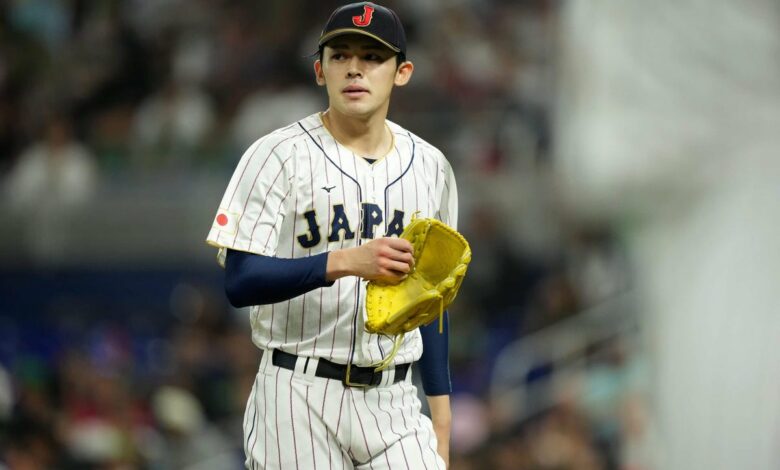Rosenthal: If Roki Sasaki signs, other international amateurs will suffer. They shouldn’t do that

The excitement over the arrival of Japanese phenom Roki Sasaki to Major League Baseball should be tempered by the likelihood that his signing will have unintended consequences: Latin American teenagers being abandoned by the team that signs him.
The 23-year-old Sasaki could perhaps be a top starter next season. The current international signing period ends on December 15. If, as expected, he delays his selection until the next period, which begins on January 15, the team he chooses will almost certainly spend its entire bonus pool on him, breaking pre-existing verbal agreements. agreements with Latin American players further away from the majors.
It is not right to rob these players of life-changing money. And baseball shouldn’t let this happen.
The system for signing international players has been broken for a long time. Because teams are limited in what they can spend on those players, many budget deals are made well in advance of the opening of the international signing period, in an effort to maximize their bonus pool allocation. Players cannot officially sign until they are 16, but teams often make verbal deals with players from the Dominican Republic and other countries who are as young as 12 years old. Such deals are technically prohibited and non-binding.
As detailed by Baseball America’s Ben Badlerthe players likely to be rejected by Sasaki’s team would be left in the lurch and their future uncertain. In fact, they would be collateral damage in a system that would no longer exist if MLB and the Players Association had agreed to an international draft in 2022. Sasaki almost certainly would have been the best choice this year. The players whose deals could be jeopardized by his signing would have been eligible for selection.
It’s not uncommon for teams to back out of verbal deals with Latin American prospects. A problem with a player’s physical condition may be one of the reasons. A reduction in a team’s international budget could be another possibility. An overzealous commitment to too many players could be a third. But as Badler notes, if a team has an agreement with a player at this late stage, less than two months before the 2025 signing period begins, the team expects to sign him. If these deals are not fulfilled, the players will likely have to accept lower bonuses from other teams, if they can find openings at all. This could cause a ripple effect as players sign with new clubs, who then have to break previous agreements to fit the new deals into their bonus pool. Players involved in this situation could also wait to sign until 2026, although teams have already made commitments to players in that class as well, and those players would be a year older.
A solution to all this is possible if MLB wants to take responsibility instead of letting a team drop the hammer on a group of eager kids, many of whom come from impoverished backgrounds: allow Sasaki to separate from the international pool of his new team to draw. Maintain existing agreements with Latin American prospects. Do the honorable thing, instead of simply blaming a dishonorable system that should have been fixed long ago.
This is not to say that Sasaki should become an unrestricted free agent, not when he still has to meet the requirement of being 25 and playing six seasons in a foreign professional league, as Japanese right-hander Yoshinobu Yamamoto had done last offseason . The same basic framework for Sasaki’s contract would apply. His bonus from whichever team wins the bid could be capped at $7.56 million, an amount equivalent to the largest available pool in the 2025 signing period. The team that happily signed him would pick up the additional cost to take.

Japan’s Yoshinobu Yamamoto was an unrestricted free agent when he signed with the Dodgers last winter. Different rules apply to his compatriot Roki Sasaki due to his age. (Kiyoshi Mio/Imagn Images)
Wait, you might say, no such exception was necessary for Shohei Ohtani, who was under the same restrictions as Sasaki when he signed with the Los Angeles Angels in December 2017. The difference then was the calendar: the international signing period started in 2017. on July 2 and closed on June 15. No existing agreements had to be broken. The deals for the bigger names in that league, including Julio Rodríguez and Wander Franco, had been official for months.
It’s ridiculous that young, established Japanese professionals are put in the same category as amateurs from Latin America and other regions, but that’s another story. In 2021, the league shifted the dates of the international signing period to run from January 15 to December 15. If Sasaki is posted soon enough, he could sign during the current period. But it was up to him and his Japanese club, the Chiba Lotte Marines, to wait.
The team with the most money in the bonus pool for the current period, the Los Angeles Dodgers, has just over $2.5 million available, according to Baseball America. A team can trade for up to 60 percent of its original allocation, but the 2025 bonus pools, ranging from $5.1 million to $7.56 million, would still be larger. More money for Sasaki and more money for the Marines, who would receive a release payment equal to 20 percent of Sasaki’s bonus under the current rules.
Separating Sasaki from the system, even as a one-time exception, would raise uncomfortable questions. What would happen the next time an international professional under the age of 25 announces his intention to play in the Majors? How would the league determine if a player was good enough to warrant the same treatment as Sasaki? And would the team that lands Sasaki gain an unfair competitive advantage if it were also allowed to sign the rest of its international class, a group that typically consists of 10 to 30 players?
Sorry, this isn’t that complicated. The current collective labor agreement expires on December 1, 2026. There is no international free agent with Sasaki’s profile and talent scheduled for the next two years. So to prevent the issue from arising again, MLB and the union should simply agree to an international draft in the next CBA. For reasons far beyond Sasaki, their motivation to create a better nurturing system for international talent should only increase.
Almost three years ago, The Athletics reported on the corruption in the current system, with teams promising contracts to players in Latin America before they were even teenagers. Both earlier this month ESPN And Baseball America reported on MLB investigations that led to the quashing of deals for potential teenagers who were found to have falsified their ages and identities.
The international draft is an imperfect solution due to the large number of opponents. It has been a sticking point between the MLB and the Players Association for years. But the union dropped its philosophical opposition to the concept during the latest round of negotiations. The league offered to do away with the qualifying bidding system in exchange for the draft. The union countered the league’s proposal with one of its own, and the two sides earned a combined $69 million. Although the parties had other disagreements, their argument mainly came down to money.
As for the imbalance between one team getting Sasaki and an entire international class, what are we even talking about? International amateurs usually sign at the age of 16. Those who make it to the top flight generally require four or five years of development, and most never even reach that level. The biggest advantage for a team that ends up at Sasaki in addition to an entire international class would be Sasaki. True, that team might also include a Juan Soto or Vladimir Guerrero Jr. brings in. But signing top international talent does not always guarantee that these players will have some impact in the major leagues. And much greater inequalities exist in sports.
If the league doesn’t want to make an exception with Sasaki, it could explore other options. Addition to the bonus pools of the other 29 teams, allowing them to sign players who lose their deals with Sasaki’s club. Find a way to provide those players with some form of financial security while allowing them to become free agents. Allowing a team to pay Sasaki in 2025 but count him in the pool in ’26, giving players the team has verbally committed to before ’26 more time to find new deals.
Clearly, there is no perfect answer. But baseball people, when forced to accept a difficult circumstance, often recognize the need to “bear it.” A general manager makes a bad trade, bear with it. If a fielder makes a critical error, own it. A starting pitcher is having a hard time, but has to pitch and carry innings.
The likelihood of Sasaki signing a contract in the near future presents a different kind of difficult circumstance. A select group of Latin American teens stand to lose deals in the hundreds of thousands, if not millions. Let’s hear someone explain why those players might have to wear it. If this sport has any conscience, this could never happen.
(Top photo of Roki Sasaki at the WBC 2023: Eric Espada / Getty Images)




